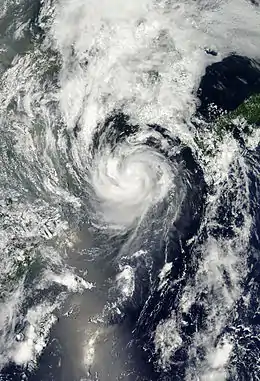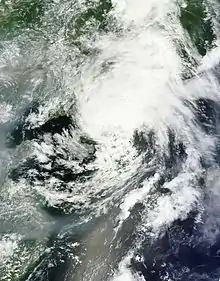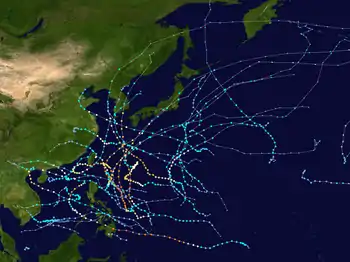Tropical Storm Khanun (2012)
Severe Tropical Storm Khanun, known in the Philippines as Tropical Storm Enteng, was the first tropical cyclone to directly impact Korea in two years. It is the 8th named storm, the 3rd severe tropical storm, and overall, the 13th tropical cyclone to be monitored by the Japan Meteorological Agency (JMA) during 2012. Khanun was also the first tropical storm to make a landfall over Korea in 2012. Khanun means "jack fruit" in Thai.[1]
| Severe tropical storm (JMA scale) | |
|---|---|
| Tropical storm (SSHWS) | |
 Tropical Storm Khanun approaching South Korea at peak intensity on July 18 | |
| Formed | July 14, 2012 |
| Dissipated | July 20, 2012 |
| (Extratropical after July 19, 2012) | |
| Highest winds | 10-minute sustained: 95 km/h (60 mph) 1-minute sustained: 95 km/h (60 mph) |
| Lowest pressure | 985 hPa (mbar); 29.09 inHg |
| Fatalities | 89 total |
| Damage | $11.4 million (2012 USD) |
| Areas affected | South Korea, North Korea, Japan, Mariana Islands |
| Part of the 2012 Pacific typhoon season | |
Meteorological history

Late on July 12, a large cluster of thunderstorms associated with a cold-core low formed a weak low pressure area northwest of Guam. On July 13, the cold-core low separated with lower, warm-core low, and the warm-core low’s convection started to organize, prompting the JMA to upgrade the system to a tropical depression late on July 14. Early on July 15, the JTWC issued a TCFA on the system, and it upgraded the system to a tropical depression later that day. On July 16, the JMA upgraded the system to a tropical storm and named it Khanun. Later on the same day, the JTWC upgraded Khanun to a tropical storm; also, the PAGASA named it Enteng as the system briefly passed the corner of the Philippine Area of Responsibility. Late on July 17, the JMA upgraded Khanun to a severe tropical storm, as Khanun's center passed over Okinoerabujima. On July 18, the JMA downgraded Khanun to a tropical storm south-southwest of Jeju Province. On July 18, 17:00 (UTC), Khanun made landfall over Haenam County, South Jeolla Province, South Korea as a tropical storm, and soon made its extratropical transition over Korea, as it weakened into a tropical depression. On July 22, the remnant low dissipated completely.
Preparations and impact

South Korea
Before Khanun made landfall over Korea, two international flights linking Incheon to Manila were canceled on July 18 according to Incheon International Airport. From Wednesday, some 90 flights scheduled for Jeju and the southern city of Pohang, as well as 115 ferry trips for the southern islands were canceled, according to transportation officials.[2][3][4]
As Khanun made its way to the central region along the west coast from Korea's southern resort island of Jeju, heavy rains and gales caused parts of a house to collapse in North Gyeongsang Province, killing an 83-year-old elderly woman.[2][3] Losses across the country were at ₩1.5 billion (US$11.4 million).[5]
The storm had deposited 97.5 mm (3.84 in) of rain in Suncheon, 53.4 mm (2.10 in) in Jeju and 37.5 mm (1.48 in) in Seoul as of 6 a.m., the weather office said. To control the water level, North Korea has been discharging water from its Hwangang Dam, located near the border with the South, since Wednesday noon, prompting South Korean campers to evacuate. No damages from the water release have been reported so far.[3]
North Korea
In North Korea, state-run media reported that at least seven people were killed in Kangwon province, with an eighth fatality reported elsewhere. It said the storm caused significant damage, destroying 650 dwelling houses, 30 public buildings, railways, roads, bridges, and various systems. The flooding also inundated nearly 3,870 homes, leaving more than 16,250 people homeless.[6]
On 29 July the North Korean government dramatically raised the death toll in the country to 88, with an additional 134 injured. The biggest loss of human life was in two counties of South Pyongan Province. At least 63,000 were made homeless by the flooding, while more than 30,000 hectares of land for growing crops were submerged and will add to growing fears of another looming famine in the country. Three hundred public buildings and 60 factories were damaged during the storm.[7]
On 31 July United Nations staff visited flood-ravaged areas in hard-hit South Pyongan and Kangwon provinces. Heavy rain continued along the western edge of the country, including the capital Pyongyang. North Korea's official media reported that premier Choe Yong Rim visited flooded towns and discussed ways to help recovery efforts.[8]
Aftermath
Torrential rains hit North Korea again on 29 and 30 July, with approximately 442 millimeters (17.4 inches) of rain recorded in Pakchon County of North Phyongan Province during a 24 hour period from 6 a.m. local time 29 July. The rains worsened the flood situation caused by Khanun, destroying railways, roads, bridges and 'many' dwelling houses.[9]
The North Korean government requested assistance from resident United Nations agencies, the Red Cross, and European Union Program Support Units. It also supported two inter-agency assessment missions in South Pyongan and Kangwon provinces on 31 July.[9][10] On 4 August, government sources announced the death toll from both Khanun and the torrential rains in late July had risen to 169, with around 400 others missing. At least 8,600 houses were destroyed and 44,000 houses were flooded, leaving more than 212,200 people homeless.[11]
See also
References
- "Rain-battered Japan braces for arrival of typhoon". Taipei Times. 18 July 2012. Retrieved 18 July 2012.
- "Typhoon Khanun passes central Korea, causing damage". The Korea Times. 19 July 2012. Retrieved 1 August 2012.
- "Typhoon Khanun dies after causing minor damage". The Korea Times. 19 July 2012. Retrieved 1 August 2012.
- "Typhoon Khanun Hits Seoul And Surrounding Cities". Arirang News. 19 July 2012. Retrieved 1 August 2012.
- Annual Global Climate and Catastrophe Report Impact Forecasting—2012 (PDF) (Report). AON. 24 January 2013. Retrieved 1 August 2013.
- "Tropical Storm Khanun kills at least 7 in North Korea". BNO News. 25 July 2012. Archived from the original on 26 July 2012. Retrieved 25 July 2012.
- "Scores killed in North Korea floods". Al Jazeera. Retrieved 29 July 2012.
- "UN visits North Korea to see flood-damaged areas". Huffington Post. Retrieved 31 July 2012.
- "Casualties feared after torrential rains hit North Korea". BNO News. 31 July 2012. Archived from the original on 19 December 2013. Retrieved 31 July 2012.
- "U.N. to send team into North Korea after floods". Reuters. 30 July 2012. Retrieved 30 July 2012.
- "WFP sends emergency food aid to North Korea after floods kill 169". BNO News. 5 August 2012. Archived from the original on 18 January 2013. Retrieved 5 August 2012.
External links
| Wikimedia Commons has media related to Tropical Storm Khanun (2012). |
- JMA General Information of Severe Tropical Storm Khanun (1207) from Digital Typhoon
- JMA Best Track Data of Severe Tropical Storm Khanun (1207) (in Japanese)
- JTWC Best Track Data of Tropical Storm 08W (Khanun)
- 08W.KHANUN from the U.S. Naval Research Laboratory
